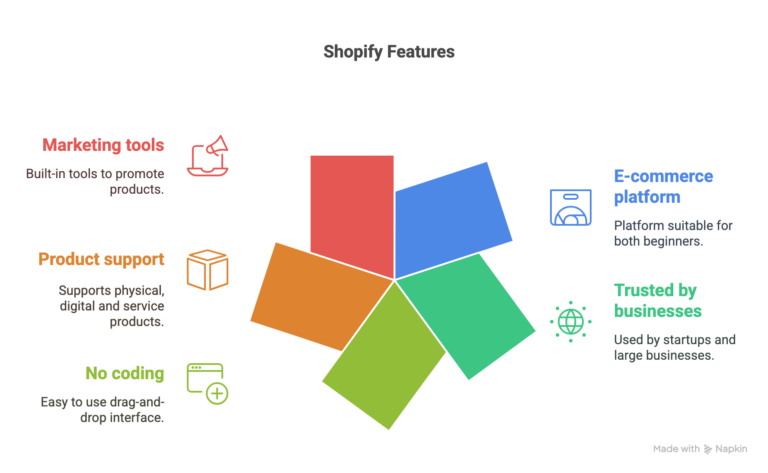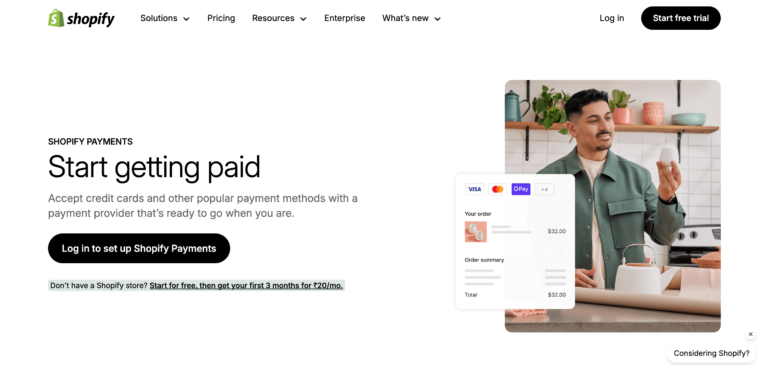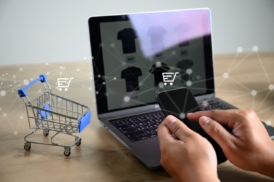Greetings! I'm Aneesh Sreedharan, CEO of 2Hats Logic Solutions. At 2Hats Logic Solutions, we are dedicated to providing technical expertise and resolving your concerns in the world of technology. Our blog page serves as a resource where we share insights and experiences, offering valuable perspectives on your queries.

QUICK SUMMARY
To sell on Shopify, sign up for an account, choose a theme, add products, set up payment methods, configure shipping, and launch. With Shopify’s user-friendly platform, you can have your store running within a day, even as a complete beginner.
Still dreaming about launching that online store instead of actually doing it? By this time tomorrow, you could be receiving your first order instead of just researching “how to sell on Shopify.”
In our experiences helping entrepreneurs launch profitable Shopify stores, we have discovered that the biggest hurdle isn’t technical know-how; it’s simply getting started. This guide eliminates every roadblock between you and your first sale.
Why Shopify is Great for First-Time Sellers
Wondering if Shopify is the right platform for your business? Let me break it down for you.

- Shopify has become the go-to e-commerce platform for beginners and experienced sellers alike, and for good reason.
- Trusted by millions of businesses worldwide, from small startups to giants like Kylie Cosmetics and Allbirds.
- No coding required, the drag-and-drop interface makes it perfect if you’re not tech-savvy.
- Supports physical, digital, and service-based products, giving you flexibility as your business evolves.
- Built-in marketing tools that help you promote your products without needing additional software.
At 2Hats Logic, we have seen countless platforms come and go, but Shopify consistently delivers the best balance of simplicity and power for new sellers.
Step-by-Step: How to Start Selling on Shopify
Ready to dive in? Here’s your roadmap to getting your Shopify store up and running.
1. Product Research & Market Validation
Most entrepreneurs pick products based on gut feeling. Smart entrepreneurs validate demand first. Google Trends reveals whether people are searching for your product idea and if that interest is growing or declining.
Here’s your step-by-step process:
Open Google Trends and enter your main product keyword. Look at the 5-year timeline, not just recent months. Rising trends show consistent upward movement over 2+ years. Declining trends might still be profitable if you enter with better positioning.
Pay attention to seasonal patterns. “Christmas ornaments” spike in November-December but drop to zero in January. Factor this into inventory planning and cash flow projections.
Compare your product against 3-4 related items. If “wireless earbuds” show steady growth while “wired headphones” decline, you’ve identified a market shift worth following.
Geographic data reveals where your customers live. If searches concentrate in California and New York, plan your initial marketing and shipping accordingly.
Amazon Best Sellers Research Method
Amazon’s Best Seller Rank (BSR) tells you what’s selling, not just what’s trending on social media.
Navigate to your product category and examine the top 100 products. Products ranking under 10,000 in subcategories indicate strong, consistent demand. Products between 10,000-50,000 show moderate demand with opportunity for newcomers.
Read reviews systematically, not randomly. Look for patterns in 2-3 star reviews. These reveal consistent problems with existing products that your version could solve.
Check review velocity. Products with 1,000+ reviews gained in the last 6 months indicate explosive growth. Products with steady 20-30 reviews monthly show sustainable demand.
Analyze pricing gaps. If top products cluster around $50-80 but reviews mention “wish it were cheaper,” a $35 alternative might capture market share.
Facebook Ad Library Competitive Analysis
Your competitors’ advertising reveals their target audiences, messaging angles, and marketing budgets.
Search your product keywords in Facebook Ad Library. Active ads indicate profitable products. If companies run the same ad for 3+ months, it’s working.
Analyze ad copy for emotional triggers. “Finally, a yoga mat that doesn’t slip” targets frustration. “Professional-grade equipment for home use” targets status and quality desires.
Study visual patterns. If all competitors use lifestyle images, product-only photos might stand out. If everyone shows products in use, studio shots could differentiate you.
Estimate ad spend through reach and frequency data. High-frequency ads (5+ times per person) suggest significant investment and profitability.
Reddit/Social Media Sentiment Analysis
Real conversations reveal unmet needs better than any market research report.
Find relevant subreddits for your product category. r/BuyItForLife reveals what people want in durable products. r/frugal shows price-sensitive customer concerns.
Search for complaint patterns. “Why do all X products break after 6 months?” indicates an opportunity for durability improvements. “Can’t find X in smaller sizes” suggests underserved market segments.
Identify emerging trends through enthusiast communities. Gaming subreddits often discuss gear 6-12 months before mainstream adoption.
Extract customer language from comments. Use their exact phrases in product descriptions and marketing copy for an authentic connection.
Pro Tip: Use a name that’s easy to remember and reflects your brand. Check if the .com domain is available for your store name. Shopify will help you secure it.
2. Set Up Your Shopify Store
Professional Domain Selection Strategies
Your domain name becomes your digital identity. Choose strategically for long-term brand building.

Brand-First vs. Keyword-Rich Domains: Brand domains (like “nike.com”) offer flexibility for product expansion. Keyword domains (like “bestsportsgear.com”) help with initial SEO but limit growth.
Consider future expansion when choosing. “HandmadeJewelry.com” restricts you to jewelry, while “ElegantCrafts.com” allows product category growth.
Domain Extension Strategy: .com remains the gold standard for e-commerce. Customers trust .com more than newer extensions.
Secure .net and .org versions to prevent competitor confusion. Redirect these to your main .com domain.
SSL and Security Considerations
Security builds customer trust and affects Google rankings. Shopify provides SSL automatically, but additional measures enhance credibility.
Display security badges prominently on checkout pages. McAfee, Norton, or Trustpilot badges increase conversion rates by 15-20%.
Multi-Currency Setup for International Expansion
Plan for growth from day one. Shopify Markets enables international selling without a complex setup.
Research target markets before enabling currencies. Canadian and UK markets often provide the easiest expansion for US businesses.
Consider payment method preferences by country. PayPal dominates in Germany, while Klarna leads in Sweden.
Warning! Don’t copy product descriptions from other websites. Google penalizes duplicate content, and you’ll miss an opportunity to explain why YOUR product is special.
3. Product Catalog Creation & Optimization

Product Title Optimization Formula: Effective titles balance search optimization with customer appeal.
Structure: Primary Keyword + Brand + Key Feature + Size/Variant

Examples:
- Basic: “Running Shoes”
- Optimized: “Men’s Lightweight Running Shoes – Nike Air Max – Breathable Mesh – Sizes 8-13”
Include 2-3 secondary keywords naturally. “Comfortable Athletic Footwear for Marathon Training” adds relevant search terms.
Keep titles under 60 characters for full Google display. Longer titles get truncated in search results.
Product Description Conversion Framework: Use the AIDA structure: Attention, Interest, Desire, Action.
Technical SEO Implementation
Schema Markup for Products: Implement the Product schema for better search display. Include name, description, price, availability, and review ratings.
Add Review schema to display star ratings in search results. This increases click-through rates by 20-35%.
Internal Linking Strategies: Link related products within descriptions: “Pair these shoes with our moisture-wicking running socks for complete comfort.”
Create category page links: “Explore our complete men’s athletic footwear collection for more options.”
4. Set Inventory and Variants
Managing your inventory properly will save you from overselling or disappointing customers.
Here’s how to set it up:
- In the product editor, scroll down to “Inventory.”
- Enter the quantity you have available
- Set an SKU (Stock Keeping Unit) to track your product
- For products with options (like sizes or colors), click “Add variant.”
- Create all the combinations you offer and set inventory for each
Shopify will automatically update inventory when orders come in, so you always know what’s in stock.
Product Variants Comparison
| Variant Type | When to Use | Complexity | Example |
| Simple | Single product | Low | Basic t-shirt (one color, one size) |
| Color/Size | Clothing, accessories | Medium | T-shirt in multiple colors and sizes |
| Bundle/Kit | Related products | High | Skincare set with multiple products |
Advanced Inventory Management
Automated Low-Stock Alerts
Set reorder points based on lead times and sales velocity. If you sell 100 units monthly with a 30-day supplier lead time, reorder at 150 units remaining.
Configure email alerts when inventory drops below thresholds. This prevents stockouts that hurt rankings and sales momentum.
Seasonal Inventory Planning
Analyze previous years’ sales patterns to predict demand. Christmas products need inventory buildup starting in September.
Factor in supplier holidays and shipping delays. Chinese New Year affects production for 2-3 weeks annually.
Implement inventory balancing between locations based on regional demand patterns.
4. Payment, Analytics & Marketing
You need a way to get paid, right? Shopify makes this easy.
Shopify Payments is the simplest option; it’s already integrated and has the lowest fees (2.2% + 30¢ per transaction in India).

To set up payments:
- Go to “Settings” > “Payments”
- Activate “Shopify Payments” and complete your business details
- Add additional payment methods like PayPal, UPI, or Cash on Delivery
Setting up multiple payment options increases your conversion rate by 30%, according to Shopify’s internal data.
Pro Tip: If you’re selling in India, enabling UPI payments can significantly increase your conversion rates, as 45% of online shoppers prefer this method.
Google Analytics 4 Enhanced E-commerce Setup
Custom Event Configuration: Track micro-conversions like email signups, video views, and product page scrolls. These predict purchasing behavior.
Set up funnel analysis to identify exact drop-off points in the customer journey.
Audience Segmentation Strategy: Create audiences based on behavior: first-time visitors, returning customers, high-value customers, and cart abandoners.
Use these segments for targeted marketing campaigns and personalized experiences.
Marketing Attribution and ROI Tracking
Multi-Touch Attribution Setup
- First-Click Attribution: Shows which channels create awareness. Useful for brand-building campaign evaluation.
- Last-Click Attribution: Reveals conversion drivers. Important for direct response campaign optimization.
- Time-Decay Attribution: Gives more credit to recent touchpoints. Ideal for longer sales cycles.
Customer Lifetime Value Calculation
- Basic CLV Formula: (Average Order Value × Purchase Frequency × Gross Margin) × Average Customer Lifespan
- Advanced CLV Modeling: Segment customers by acquisition channel, product category, and behavior patterns. Each segment has different value profiles.
Use CLV to guide acquisition spending. If email customers have $300 CLV while social media customers have $150 CLV, allocate budgets accordingly.
5. Shipping, Operations & Advanced Automation
Shipping can make or break your business. Set it up carefully:
- Go to “Settings” > “Shipping and delivery”
- Create shipping zones for areas you’ll serve (local, domestic, international)
- Add shipping rates for each zone (flat rate or calculated based on weight)
- Consider offering free shipping over a certain order value
Remember that shipping costs are one of the top reasons for cart abandonment. Be transparent about your shipping fees early in the checkout process.
Need help with your Shopify store setup?
Advanced Shipping Strategy
Zone-Based Pricing Optimization
- Zone 1: Local/regional (1-2 day delivery)
- Zone 2: National (3-5 day delivery)
- Zone 3: Remote areas (5-7 day delivery)
Price shipping to maintain profitability while staying competitive. Use calculated shipping for large or heavy items.
Free Shipping Threshold Calculation
Analyze average order values and increase free shipping thresholds to boost AOV. If the average order is $65, set free shipping at $75-80.
A/B test different thresholds: $75 vs. $85 vs. $99. Monitor both conversion rates and profitability.
Automation Implementation
Shopify Flow Setup:
- Automatically tag orders by value, location, or product type
- Send custom notifications for high-value orders
- Route orders to appropriate fulfillment centers
- Generate shipping labels automatically
Inventory Management Automation
Low Stock Workflows:
- Automatic reorder triggers when inventory hits minimum levels
- Supplier notification systems for urgent restocking
- Product page updates showing limited availability
- Marketing team alerts for promotional planning
Customer Service Automation
Helpdesk Integration: Connect Shopify with Zendesk, Freshdesk, or similar platforms. Automatically create tickets for returns, complaints, and inquiries.
Chatbot Implementation: Deploy chatbots for common questions: order status, shipping times, return policies, and product recommendations.
Set up escalation rules for complex issues requiring human intervention.
6. Launch Your Store
You’re almost there! Before going live:

- Install a theme that matches your brand (free or premium)
- Customize your homepage, about page, and contact information
- Set up your domain (either buy through Shopify or connect your existing one)
- Remove the password protection by going to “Online Store” > “Preferences.”
- Test your checkout process by making a test order
- Share your store with friends and family for feedback
Your store is now ready to welcome customers and process orders!
Content Marketing Framework
- 12-Month Blog Content Calendar: Build trust with your audience by providing genuine value through educational content. Focus on solving common customer problems with beginner-friendly guides and tutorials.
- Educational Content Strategy: Start with educational pieces that address common customer questions and concerns. Create beginner guides, troubleshooting articles, and how-to content for maximum value.
- Comparison and Review of Content: Position your products strategically against competitors once you’ve established educational authority. Create detailed comparison pieces that highlight your unique advantages clearly.
- Advanced and Expert Content: Demonstrate deep expertise by creating content that appeals to professionals in the industry. Cover advanced techniques and emerging trends that showcase your knowledge.
- Seasonal and Promotional Content: Capitalize on seasonal buying patterns with targeted holiday and year-end content. Develop gift guides and trend reviews that drive purchase decisions.
Paid Advertising Mastery
- Facebook/Instagram Advertising Strategy: Successful Facebook advertising requires a systematic approach across three distinct campaign types. Structure campaigns as a funnel: Awareness, Consideration, Conversion, with appropriate budget allocation.
- Awareness Campaigns: Target broad audiences interested in your product category using engaging video. Focus on reach and engagement metrics rather than immediate sales.
- Consideration Campaigns: Target website visitors and engaged audiences with content showcasing product features. Measure success through click-through rates and video completion percentages.
- Conversion Campaigns: Focus the highest budget allocation on warm audiences most likely to purchase. Feature clear calls-to-action while tracking ROAS and cost per acquisition.
- Creative Testing Framework: Systematic creative testing prevents guesswork and optimizes ad performance through data. Test one element at a time: headlines, images, video length, buttons.
- Google Ads for E-commerce: Google Shopping campaigns capture high-intent customers actively searching for products to purchase. Organize products into themed ad groups with optimized titles and images.
Email Marketing Automation
- Welcome Series Setup: New subscribers represent your most engaged audience, deserving comprehensive brand introduction. Design a 14-day welcome series that builds relationships through strategic touchpoints.
- Cart Abandonment Recovery: Cart abandonment affects 70% of online shoppers, representing massive revenue opportunities. Implement a three-email sequence: gentle reminder, objection handling, limited-time discount offer.
7. How to Increase Shopify Sales Through Conversion Rate Optimization
A/B Testing Framework Development
Hypothesis Formation Process
Problem Identification: Use analytics to identify conversion bottlenecks. Common issues include high bounce rates, cart abandonment, and low add-to-cart rates.
Hypothesis Structure: “If we [make specific change], then [target metric] will [increase/decrease] by [expected amount] because [reasoning based on user psychology].”
Example: “If we add customer reviews above the product price, then conversion rates will increase by 15% because social proof reduces purchase anxiety for new customers.”
Testing Prioritization Matrix
High Impact, Low Effort:
- Button color and text changes
- Headline modifications
- Trust badge additions
- Product image order optimization
High Impact, High Effort:
- Checkout process redesign
- Mobile experience overhaul
- Product page layout restructuring
- Navigation menu reorganization
Testing Implementation:
Use Shopify’s built-in testing tools or third-party platforms like Optimizely or VWO.
Test one element at a time for clear results. Simultaneous tests can create confusing data.
Run tests for statistical significance (minimum 95% confidence level) before making decisions.
Cart Abandonment Reduction Strategies
Checkout Optimization Techniques
Form Field Reduction: Minimize required information to essential fields only. Name, email, address, and payment information are sufficient for most orders.
Use auto-fill capabilities and address validation to speed completion.
Progress Indicators: Show customers exactly where they are in the checkout process. “Step 2 of 3: Shipping Information” reduces uncertainty.
Multiple Payment Options: Offer credit cards, PayPal, Apple Pay, Google Pay, and buy-now-pay-later options like Klarna or Afterpay.
Different customers prefer different payment methods. More options increase completion rates.
Shipping Cost Transparency: Display shipping costs early in the process. Surprise fees at checkout are the #1 cause of abandonment.
Offer calculated shipping at the cart level before checkout begins.
Mobile Checkout Optimization:
Single-Column Layout: Use single-column forms on mobile devices. Side-by-side fields are difficult to complete on small screens.
Large Touch Targets: Make buttons and form fields large enough for easy tapping (minimum 44px height).
Auto-Complete Integration: Enable browser auto-complete and auto-correct for faster form completion.
Trust Signal Implementation
Security Badge Placement
Position security badges near payment information and on checkout pages. McAfee, Norton, and SSL badges increase customer confidence.
Money-Back Guarantee Display
Feature guarantees prominently on product pages and checkout. “60-Day Money-Back Guarantee” reduces purchase risk perception.
Customer Review Integration
Display reviews on product pages, not just dedicated review sections. Recent reviews have more impact than older ones.
Show review averages and total review counts in search results and product grids.
Social Proof Elements
Recent Purchase Notifications: Display real-time purchase notifications: “John from Texas just bought this item.”
Customer Count Displays: Show how many customers have purchased: “Join 2,500+ happy customers.”
Trust Pilot Integration: Display Trustpilot ratings and reviews for overall business credibility.
8. Technical Performance Excellence
Site speed affects both rankings and conversions. Most entrepreneurs ignore this critical factor.
Page Speed Optimization
Technical performance improvement includes image optimization workflows, code minification, CDN setup, and app auditing processes.
Core Web Vitals optimization addresses Google’s ranking factors: Largest Contentful Paint, First Input Delay, and Cumulative Layout Shift improvements.
9. Scaling Strategies for Growth
Most guides end at launch. Successful businesses plan for scale from day one.
Hiring strategies cover e-commerce team structure design, role definitions, remote management, and performance tracking systems.
International expansion planning includes market research, multi-currency implementation, compliance requirements, and localization strategies.
How to Sell on Shopify for Free
On a tight budget? Here’s how to minimize costs while getting started:
- Use Shopify’s 3-day free trial, then transition to the $1/month plan for your first three months
- Stick with a free theme (like Dawn or Broadcast)
- Take your product photos instead of hiring a photographer
- Use only free apps initially (like Oberlo for dropshipping or Product Reviews)
- Create your logo using a free tool like Canva
- Handle your customer service instead of hiring help
While you can’t operate completely free forever, this approach keeps your initial investment minimal while you test your business idea.
Warning! Free doesn’t mean unprofessional. Make sure your product photos and descriptions are high-quality, even on a budget.
What Can You Sell on Shopify?
Wondering if your product idea will work on Shopify? The platform is incredibly versatile.
Here are the main categories that perform well:
Physical products: From handmade crafts to wholesale products. The classic e-commerce model.
Digital downloads: Ebooks, templates, courses, software, and other digital goods (no shipping required!).
Subscriptions: Regular delivery of products like coffee, beauty boxes, or content memberships.
Print-on-demand products: Custom-designed t-shirts, mugs, posters printed only when ordered.
Services and bookings: Consulting, classes, appointments, and other time-based offerings.
The platform is designed to handle almost any business model you can imagine.
Pro Tip: “Focus on making your first sale before investing in premium tools. Once you’re profitable, you can reinvest in better themes and apps.” This approach has helped many of my clients bootstrap successful stores.
Tips to Get Your First Sale
The hardest part of e-commerce is getting that first sale. Here’s how to break through:
- Add social proof: Even if you’re just starting, get friends or beta customers to leave honest reviews.
- Use Shopify’s free marketing tools: Set up automated abandoned cart emails and product recommendation features.
- Share on social media: Don’t just post your store link, share the story behind your products.
- Run a small targeted ad: Even $5-10 can bring qualified traffic if you target carefully.
- Offer a launch discount: Create urgency with a limited-time offer for new customers.
- Engage in communities: Find online groups where your potential customers hang out and provide value before promoting.
Remember that the first sale is often the hardest. Once you’ve proven your concept, growth becomes easier.
Ready to accelerate your Shopify success?
You’re Ready to Sell
Starting an online store has never been more accessible than it is in 2025. Shopify has democratized e-commerce, allowing anyone with a product or service to reach customers worldwide.
Remember these key points:
- Start simple and improve over time
- Focus on great product photos and descriptions
- Choose the right pricing strategy for your market
- Set up proper shipping and payment methods
- Market your store strategically to get that crucial first sale
The most successful Shopify stores weren’t built in a day. They started small, learned from customer feedback, and continuously improved.
What’s stopping you from starting today? The sooner you begin, the sooner you’ll learn what works for your specific business.
Need expert help launching your Shopify store? 2HatsLogic specializes in building high-converting Shopify experiences that grow with your business. Contact us today to discuss your project!
FAQ
Can I sell internationally with Shopify?
Absolutely! Shopify supports multiple currencies and international shipping. You'll need to consider customs fees, international shipping costs, and potentially translating your store for different markets.
How do I collect tax on Shopify?
Shopify can automatically calculate and add taxes to your orders. Go to Settings > Taxes to configure tax rates for different regions. In India, you'll need to set up GST rates based on your products and customer locations.
Can I sell without inventory (dropshipping)?
Yes! Many Shopify sellers use dropshipping, where suppliers ship products directly to customers. Apps like Oberlo and DSers connect you with suppliers, and you never hold inventory yourself.

Related Articles







